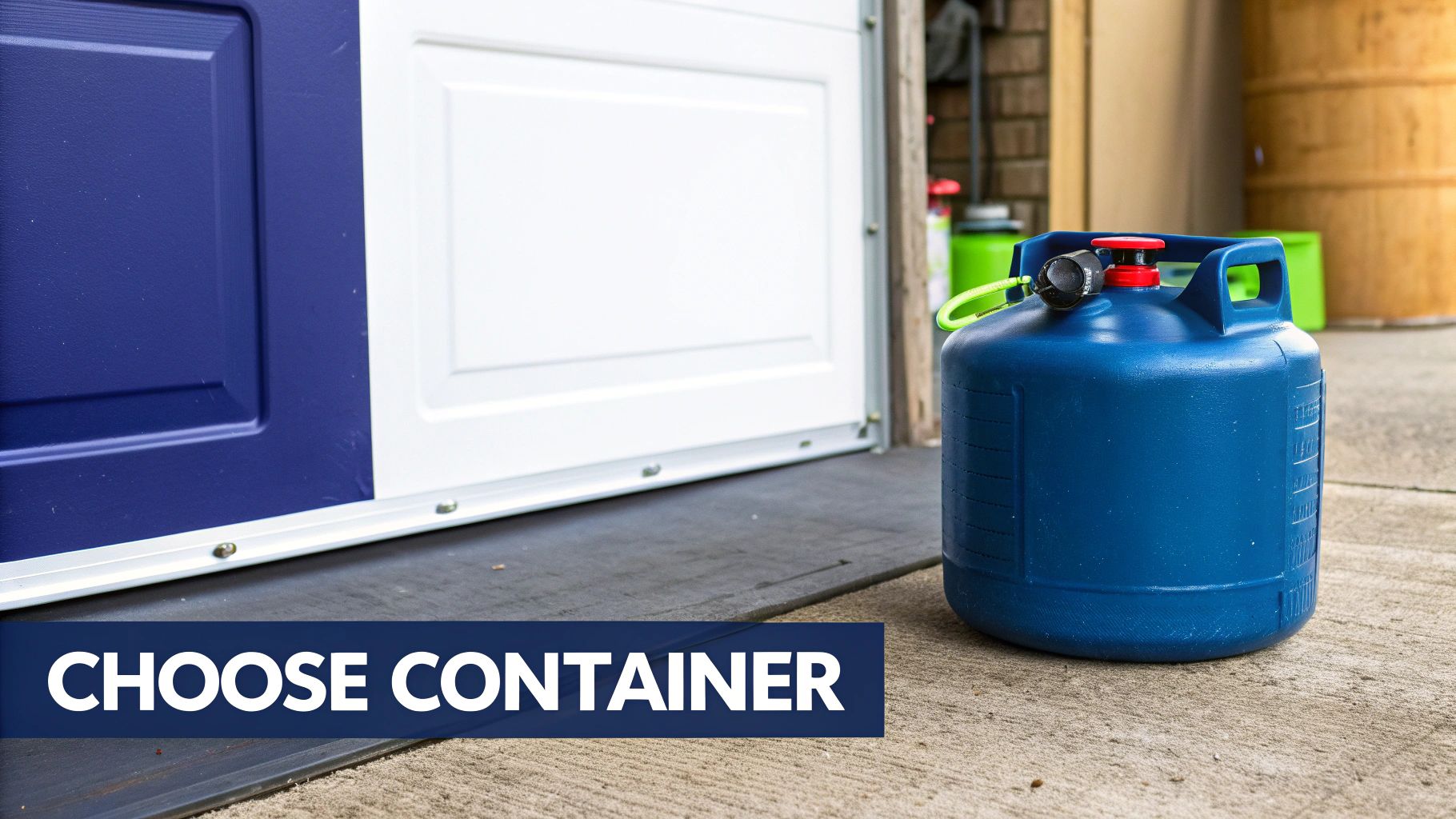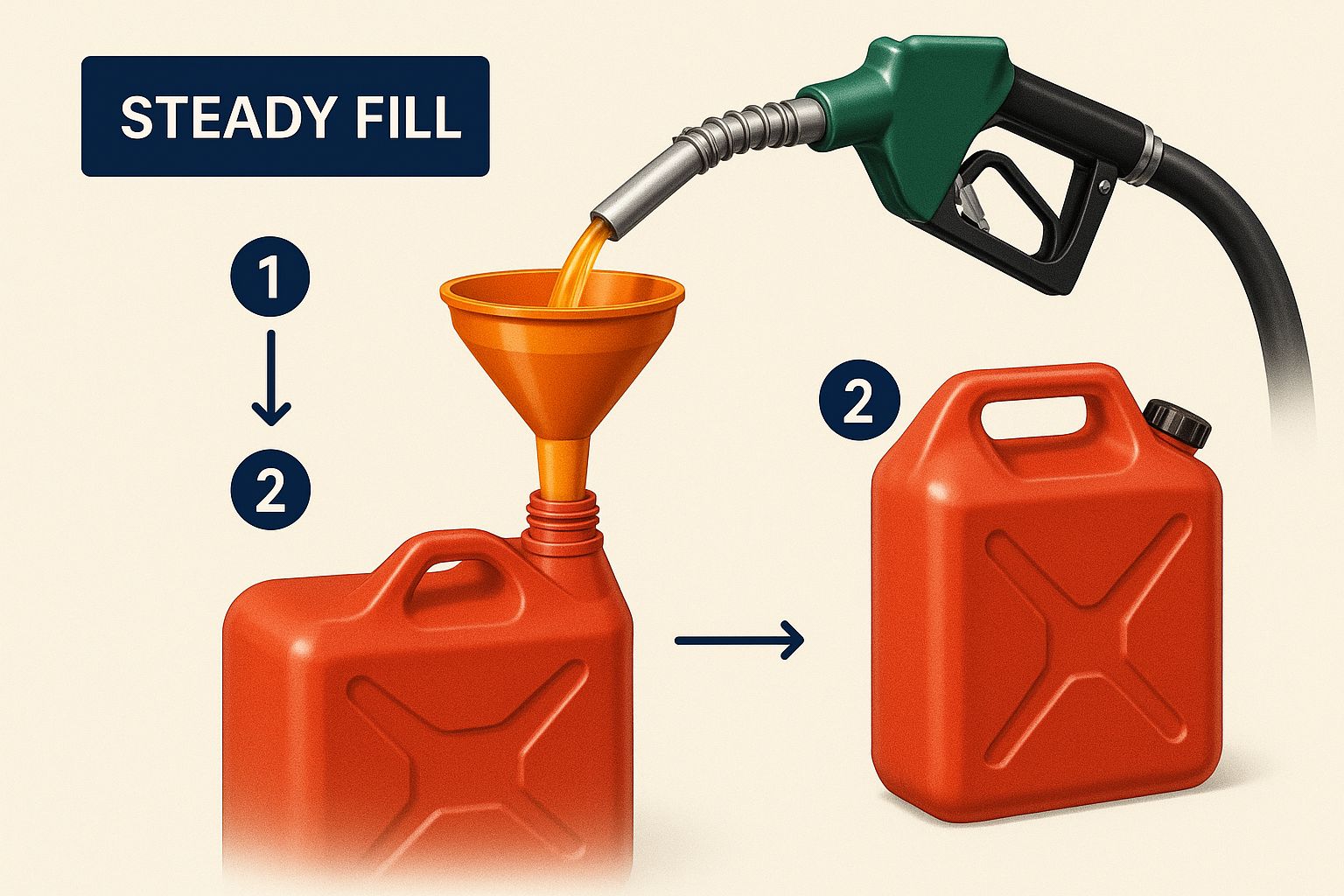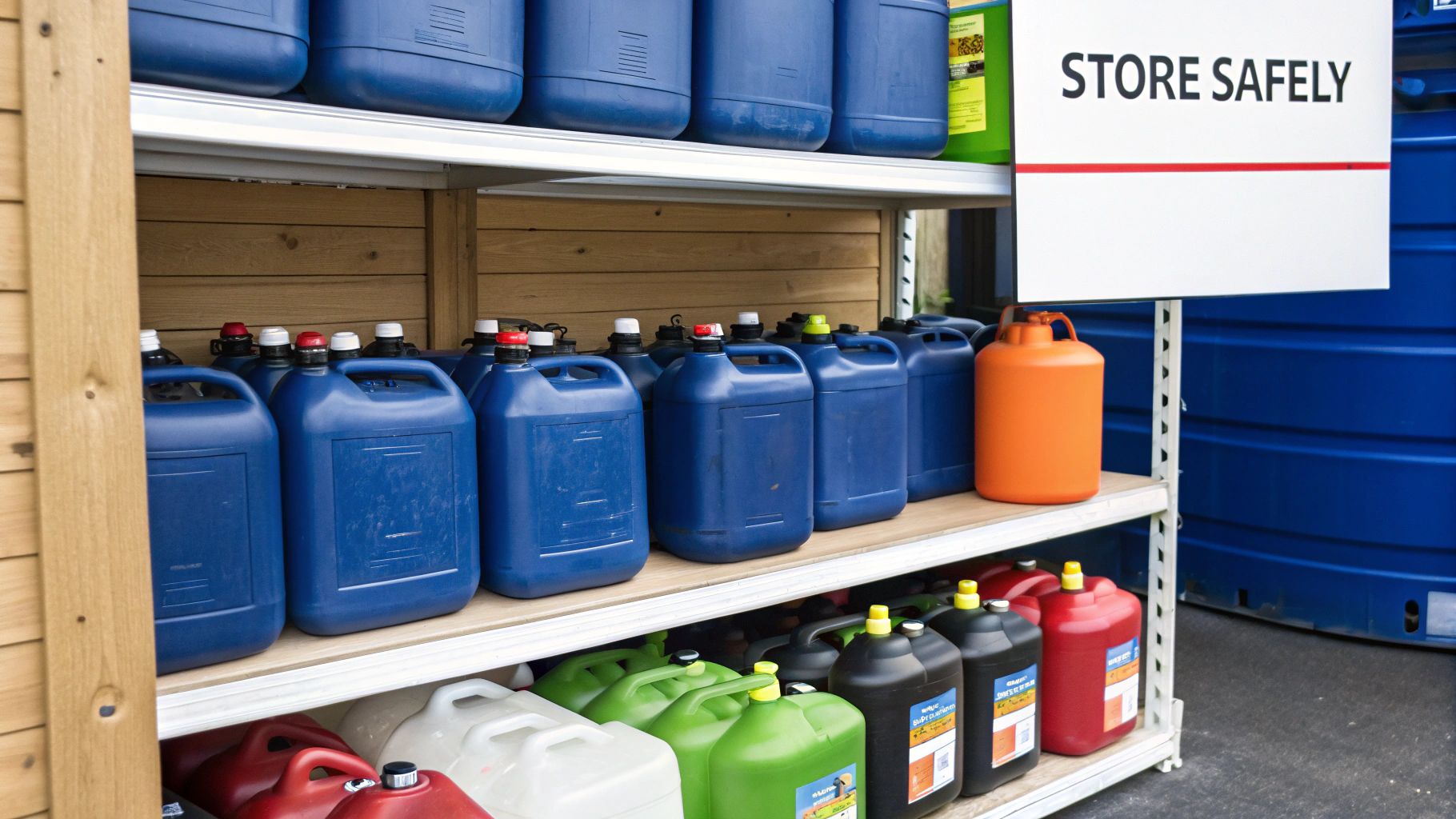When it comes to filling a gas container, the safest approach is always the simplest. Place it on the ground, use an approved container, and fill it slowly to prevent any splashes. Taking a moment to follow these steps isn't just about being careful; it’s about preventing a serious accident before it ever has a chance to happen.
Why Safe Fuel Handling Actually Matters

Before you even grab the pump, let's get real about why these safety rules exist. It's easy to get complacent, especially if you've filled a can a hundred times. But gasoline is highly volatile, and its vapors are the real threat. A single spark is all it takes to ignite those fumes, turning a routine chore into a dangerous emergency in a split second.
This isn't just about following rules. It’s about knowing the risks so you can handle fuel with the respect it deserves, every single time.
The Hidden Dangers of Static and Vapors
One of the most overlooked risks is static electricity. Ever seen someone fill a gas can in the bed of a truck with a plastic liner? That's a huge mistake. The container isn't grounded, allowing static electricity to build up. When the metal fuel nozzle gets close, that static can discharge as a spark, igniting fuel vapors in a flash.
Key Takeaway: Always place your gas container on the ground before and during filling. This simple action allows any potential static charge to safely dissipate, dramatically reducing the risk of a spark.
Fuel vapors are also heavier than air, meaning they can travel along the ground and find an ignition source you might not even be thinking about, like a pilot light or a running engine nearby. That’s why good ventilation and situational awareness are non-negotiable. For professionals working in these conditions, using ATEX certified equipment for explosive atmospheres is often a requirement for this very reason.
As global fuel consumption continues to climb—with natural gas demand hitting a record 4,122 billion cubic meters between 2024 and 2025—more people are handling fuel than ever. These fundamental safety principles are what keep everyone safe.
Here's a quick checklist I run through every time I'm at the pump. It’s a great way to build a safe, consistent habit.
Quick Safety Checklist Before You Start
| Safety Check | Why It Matters |
|---|---|
| Turn Off Engine | Prevents accidental sparks from the vehicle's electrical system. |
| No Smoking or Flames | Obvious but critical. Fuel vapors are highly flammable. |
| Place Can on Ground | Discharges static electricity safely, preventing sparks at the nozzle. |
| Use Approved Container | Ensures the container is designed to safely hold flammable liquids. |
| Fill Slowly | Minimizes splashing and the release of excess fuel vapors. |
| Don't Overfill | Leaves room for fuel to expand with temperature changes, preventing leaks. |
Keeping these points in mind turns a potentially risky task into a routine one. A little bit of caution goes a long way.
Choosing the Right Gas Container
Before you even think about heading to the pump, you’ve got to start with the right container. This is the first, and honestly, the most critical step in filling a gas container safely. Forget about the color for a second—what you really need to look for are the safety certifications.
Make sure any can you buy has a UL (Underwriters Laboratories) or ASTM (American Society for Testing and Materials) approval stamp on it. These aren't just fancy labels. They're your proof that the container has been put through its paces and passed tough tests for things like durability and leak resistance. Using an old milk jug or some random plastic bucket is asking for trouble; they can break down, leak fumes, or even build up a dangerous static charge.
Plastic vs. Metal Containers
So, plastic or metal? It's a classic debate.
Most people get by just fine with a high-density polyethylene (HDPE) plastic can. They're light, they won't rust, and they’re easy on the wallet. For fueling up your lawnmower or a small generator, they're perfect. If you're looking for recommendations, we put together a guide on the top portable gasoline container picks that you might find helpful.
Metal cans, on the other hand, are the heavy-duty option. They're built to last and are a great choice if you need long-term storage or use fuel in a professional setting where it might get banged around. Yes, they’re heavier and you have to watch out for rust, but they offer unmatched protection against punctures.
Pro Tip: Whether you choose plastic or metal, give your can a quick once-over for cracks, rust, or any damage before you use it. A compromised container is a dangerous one, plain and simple.
Why Modern Nozzles Are a Good Thing
You've probably noticed that new gas cans have some pretty funky-looking nozzles. These are spill-proof spouts, and while they can feel a little awkward at first, they’re there for a very good reason. They’re designed to prevent spills and cut down on the gasoline vapors that escape into the air.
These nozzles only allow fuel to flow when you've got them properly seated and engaged. It's a small change that makes filling up much cleaner and safer for everyone. Spend a minute getting familiar with how your can's nozzle works—it'll make your life a lot easier next time.
It's interesting to see how safety evolves on every level. While projects like the Plaquemines LNG facility are set to boost global supply by an expected 25 bcm, the core principles of safe fuel handling start with us, right at the pump. You can read about the shifting global gas market fundamentals for 2025 to get the bigger picture, but it all comes back to the basics. Choosing a certified, well-designed container is your small but essential part in keeping things safe.
The Right Way to Fill Up at the Pump
Alright, let's get down to the nitty-gritty of filling your gas can. You’ve got your approved container, you're at the station, and now it's time to put all that safety knowledge into practice. Having a solid, repeatable routine here is what separates a safe fill-up from a risky one.
The single most important thing you'll do happens before any gas starts flowing. Always—and I mean always—take the container out of your vehicle. Place it flat on the concrete, a good distance away from your car.
Never, ever fill a gas can while it’s sitting in a truck bed, trunk, or on the floor of your car. Why? Plastic bed liners and even the rubber on your tires act as insulators, letting static electricity build up. That static can create a spark between the fuel nozzle and your can, which is the last thing you want. It's a textbook way to start a dangerous flash fire. For a deeper dive on this, check out our guide on where portable gasoline fuel tanks should be filled.
Grounding and Filling Technique
With your can firmly on the ground, take off the cap and put the fuel nozzle inside. The key here is to maintain constant contact between the metal nozzle and the opening of the gas can the entire time you're filling. This simple action grounds the can, letting any potential static charge dissipate safely.
Start filling slowly. Don't just jam the handle down full blast. That's a surefire way to get fuel splashing back at you, creating a mess and releasing a cloud of flammable fumes. A controlled, steady stream is what you're aiming for. It's safer and you won't waste fuel.
This infographic shows exactly what a smooth, controlled fill looks like.

As you can see, the goal is a clean pour without any splashing. This isn't just about being neat; it's a core safety practice.
Knowing When to Stop
I see this mistake all the time: people trying to cram every last possible drop of fuel into their container. Don't do it. You should only fill your gas can to about 95% of its capacity.
Important Reminder: Never top off a gas can. That little bit of air you leave at the top is essential. Gasoline expands when it gets warm, and that air gap gives the vapors room to expand without building up dangerous pressure inside the can.
Once you’re close to that 95% mark, let go of the handle. Carefully pull the nozzle out, letting any final drips fall back into the container, not on the ground. Then, screw the cap back on tightly, right away, to lock in the vapors and prevent spills.
Follow these simple steps every time, and filling up your gas can becomes just another safe, easy part of your routine.
Getting Your Fuel Home and Stored Safely
Alright, you’ve filled your gas container. Good job, but you're not done yet. Getting that fuel home safely and storing it the right way is just as important as the fill-up. Let's be honest, a loose gas can sliding around in your car is just asking for trouble—spills, fumes, the whole mess.
The first rule is to always keep the container upright and secure. If you've got an SUV, you can often wedge it in the back, maybe propped up by a couple of other sturdy items. For a truck bed, a few bungee cords or tie-down straps are your best friend. They'll keep it from tipping over on a sharp turn. It's also a good idea to crack a window, just to keep the air moving and prevent any fumes from building up inside.
Smart Fuel Storage Habits
Once you’re home, the real question is where to put it. You need a spot that’s cool, well-ventilated, and, most importantly, far away from anything that could ignite the fumes. A detached shed or a garage is usually the best bet.
Whatever you do, never store gasoline inside your house. That includes the basement, a utility closet, or anywhere near appliances. Those gasoline vapors are heavier than air and can creep along the floor until they find an ignition source, like the pilot light on your water heater or furnace. For a deeper dive, take a look at our complete guide on how to store gasoline safely.
A Critical Rule of Thumb: Keep your fuel container at least 50 feet away from any potential ignition source. This means pilot lights, electric motors, and any kind of open flame.
How to Keep Your Fuel From Going Bad
Did you know gasoline has a shelf life? It can start to break down in as little as 30 days. Using old, stale gas is a great way to gunk up an engine. If you think you'll be storing that fuel for more than a month, you absolutely need a fuel stabilizer.
It’s a simple additive that stops the fuel from oxidizing and forming nasty deposits. Just pour the right amount into the container right after you fill it, and you can extend its life for up to two years. It's a small step that makes a huge difference.
Think about it on a bigger scale: keeping our national fuel reserves stable is a massive undertaking. In the U.S., working gas inventories recently topped 3.5 trillion cubic feet, which was 6.1% higher than the five-year average. You can see more on natural gas market indicators. For your own supply, a little bit of stabilizer ensures your fuel is fresh and ready to go when you need it most.
Common Fuel Handling Mistakes to Avoid

It’s easy to get complacent when you’ve filled a gas can a hundred times. But that’s when simple mistakes happen, and with gasoline, even small slip-ups can be dangerous. Knowing the right way to do things is one thing; knowing what not to do is just as critical.
Let’s walk through a few of the most common—and hazardous—mistakes people make at the pump so you can steer clear of them.
Static Electricity: The Invisible Danger
Probably the most frequent mistake I see is someone trying to fill a gas can while it's still sitting in their car or, even worse, in a truck bed with a plastic liner. It seems like a time-saver, but it's incredibly risky.
That plastic liner insulates the container, preventing it from being properly grounded. As fuel flows, static electricity builds up. When the metal nozzle gets close to the can, that static can discharge as a spark, which is all it takes to ignite gasoline vapors.
Crucial Safety Reminder: Always, always place your gas container firmly on the ground before you start filling. This simple action grounds the can and lets any static electricity dissipate safely, practically eliminating the risk of a fire.
Overfilling and Ignoring Expansion
Trying to squeeze every last drop into the can is another classic mistake. It feels efficient, but it’s a bad idea. Gasoline, like any liquid, expands when it gets warm. If you fill a container to the very brim, you leave no room for this expansion.
As the temperature rises, the pressure inside the can builds up dramatically, which can force fuel out through the seals or even cause the container to rupture.
Here's how to get it right:
- Leave a Gap: Never fill a container more than 95% full. That bit of empty space is a crucial safety buffer for vapor expansion.
- Cap It Tight: As soon as you’re done filling, screw the cap on securely. This prevents spills and contains the fumes.
- Wipe It Down: If you dribbled any gas on the side of the can, wipe it off with a paper towel before putting it back in your vehicle.
A Quick Guide to Safe Practices
We've all been in a hurry, but a few seconds of caution at the pump can prevent a serious accident. Here’s a look at some common shortcuts and their safer alternatives.
| Common Mistake | The Safe Alternative | Potential Risk |
|---|---|---|
| Filling a can in a truck bed | Always place the can on the ground before filling. | Static spark could ignite fuel vapors. |
| Topping off to the very brim | Stop at 95% capacity to leave room for expansion. | Pressure buildup can cause leaks or ruptures. |
| Using a cell phone at the pump | Keep your phone in your pocket and focus on the task. | A phone can be a source of distraction or ignition. |
| Leaving the cap loose | Tighten the cap immediately after filling. | Spills and dangerous fume leaks. |
Avoiding these common errors is straightforward. A little bit of awareness and sticking to the proper procedure ensures every trip to the gas station is a safe one.
Got questions about filling up your gas cans? You're not alone. Here are some of the most common things people ask, along with some straightforward answers to keep you safe.
How Much Gas Should I Actually Put in the Can?
It’s tempting to fill it to the brim, but you really need to stop at about 95% full. That little bit of empty space—what we call "headspace"—is absolutely critical.
Gasoline expands and contracts with temperature changes. Without that room to breathe, the pressure inside the can could build up, potentially causing a dangerous leak or even rupturing the container.
What's the Big Deal About Filling a Gas Can in a Truck Bed?
This one is a huge safety issue. Yes, it's incredibly dangerous. The plastic liner in your truck bed acts as an insulator, and so do the rubber tires on your vehicle. This prevents static electricity from grounding out.
When you start pumping, a static spark can jump from the nozzle to the can and ignite the gas fumes. It happens fast and the result is often a fire.
There's no getting around this one: always, always place the gas can flat on the ground before you start fueling. It's a simple step that prevents a disaster.
How Long is Stored Gasoline Good For?
Believe it or not, gasoline starts going bad surprisingly quickly. In as little as 30 days, oxidation and evaporation can begin to degrade its quality.
If you need to store gas for longer, you'll want to add a good fuel stabilizer right after you fill up. This can keep it fresh for a year, sometimes even two. Just make sure you store the can in a cool, well-ventilated spot far from any heat sources.
When you're fueling up on the water, you want a system that's just as safe and even more convenient. That's where CLiX Fueling Solutions comes in. Our system gives you a spill-free experience by automatically stopping the fuel flow when the tank is full, protecting your boat and our waterways.
See how our innovative fueling system works and take the guesswork out of gassing up.












